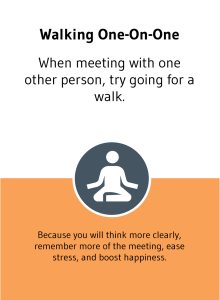
5 Tips From the Science of Learning
The world is always changing, so you need to be learning. The problem is that your human memory is imperfect, so you forget names, decisions, and facts that you need. Fortunately science can help you learn and remember better.
Those same studies can help you and me do a better job of teaching. This is extremely important to me, because my mission is to help others learn and apply the science of thriving at work. I’ll fulfill that mission much better if I can use science to help you learn and apply more science.
I hope you’ll use the following tips to remember these tips!
- Give a $#!+ If you don’t care, you won’t learn. If you must learn something boring, science suggests you might make it more emotional. Ask yourself why you are learning, and how you will use what you learn. For example, in our online course Thrive from 9-5: The Science of Being Happy and Productive at Work, in the first video chapter I explain all the benefits science has found come with happiness, including productivity, creativity, resilience, health, and longevity. Most of us care deeply about at least one thing in that list! By getting you to care, I’m setting you up to learn better. Find the motivation for your learning. Ask five whys if you have to.
- Picture the memories Our brains have far more “real-estate” for processing vision than any other sense. If you aren’t making information visual, you are failing to take advantage of many parts of your brain that can help you learn. If you want to remember something, visualize it. For example, I’ve been quite bad with names over the years. After learning more about the science of memory, I try to put an image on someone to help remember their name. My wonderful dental hygienist is named Julia; I picture her with a huge jewel right in the middle of her forehead. The fact that it’s weird makes it more emotional, which also helps.
- Learn in more than one place Memories are attached to physical locations. I love teaching our workshop Remember This! The Science of Learning and Memory because the whole session is one big interactive exercise. I have audiences build what’s called a “memory palace”. A memory palace is a familiar space–such as your own home–that you fill with emotional images to help you remember something. You can use this technique to remember these five tips I’m giving you now. If you want to play along, choose a route with five different stops through a space you know well (such as five spots in your home). Picture walking into your current home and in the first room or space you enter, put an image of a relative of yours feeling intense emotions. That represents the first tip: you have to care to learn. Really picture that image of your relative. I’m suggesting a relative because you usually have strong feelings of one kind or another about your relatives. Once you’ve got that image in your brain, move to another nearby space in your home and picture it entirely covered with images. Picture images all over the tables, chairs, or whatever else is in that space. That’s weird, which make this image of pictures more emotional, therefore more memorable. Now in a third space, put an enormous globe, map, or atlas, to represent different spaces. Again emotions help with learning, so if you globe is a weird color or dripping like a Dali painting, you’re even more likely to remember that mental image. Now start over again and see if you can picture all three images you just created in those three spots you chose. If so, you’ve experienced how memories can be tied to physical locations. This means if you want to learn something as well as possible, learn it in multiple locations. If you must learn something in only one location, try to learn it where you will use that information. (You can extend this “memory palace” technique on your own to learn the following two memory tips as well.)
- Exercise your memories Studies suggest that bodies in motion have brains that produce
 more BDNF (brain-derived neurotropic factor), which you can think of as learning aid. If
more BDNF (brain-derived neurotropic factor), which you can think of as learning aid. If
you’ve been in a workshop of mine, you know that I love to take advantage of this tip and the previous one–remember what it was? (It was that memories are tied to physical locations so we should learn in more than one place.) After each major section of a workshop, I send people on “walking 1:1’s”, talking about what they’ve learned and how they will apply it, outside of the space I’m facilitating in. By learning the material in multiple spaces, they take advantage of the fact that memories are tied to physical locations. By walking around, they increase blood flow to the brain and likely increase recall as a result. - Test yourself Testing is often criticized, but the scientific evidence is clear: testing causes at least some kinds of learning. Because of this, we have fun quizzes at the end of each of the seven video chapters in our online course Thrive from 9-5; The Science of Being Happy and Productive at Work. You will remember the science of happiness if you test yourself on it. When you ask yourself: “What were the previous 4 memory tips I just learned?”, that attempt to recall that information signals the brain that the information is going to get used, therefore should be retained. So please pause right now and test yourself: what are the five memory tips you’ve just learned, including this one on testing?
Practice these tips in order to better keep up with a rapidly changing world…and to remember your dental hygienist’s name! Of course, if you are a teacher like me, you can think about how to apply these tips when teaching others as well as learning.